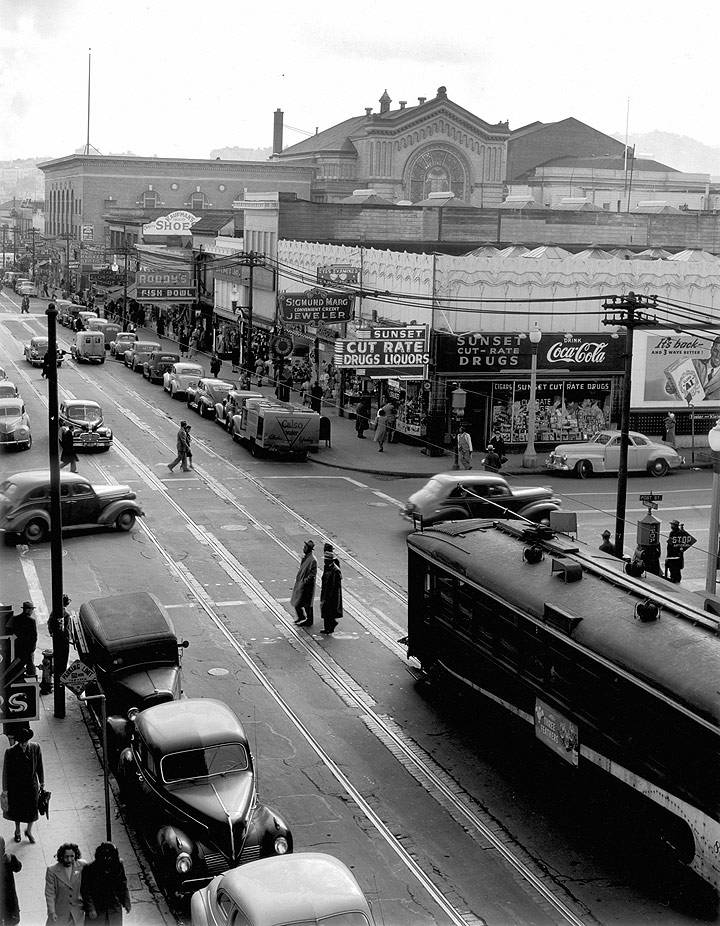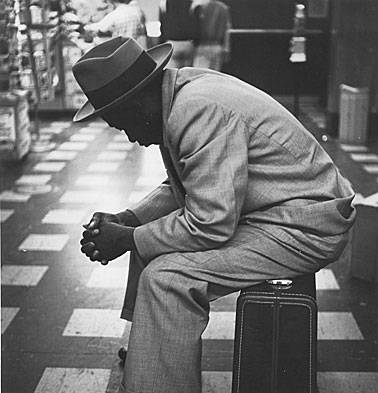The Fillmore: Black SF: Difference between revisions
(added two David Johnson photos) |
No edit summary |
||
| (4 intermediate revisions by 2 users not shown) | |||
| Line 18: | Line 18: | ||
''Photo courtesy [http://www.sfblackhistory.org/ African American Historical and Cultural Society], San Francisco, CA '' | ''Photo courtesy [http://www.sfblackhistory.org/ African American Historical and Cultural Society], San Francisco, CA '' | ||
[[Image:Fillmore Street at night during the curfew caused by the 1966 Bayview-Hunters Point riots AAK-1656.jpg]] | |||
'''Fillmore Street at night during the curfew imposed after the [[The Hunters Point Riot|September 27-October 1, 1966 Hunter's Point uprising]].''' | |||
''Photo: San Francisco History Center, SF Public Library'' | |||
<iframe src="https://archive.org/embed/CaloMiddioneAndAngelaDavisAndCommunityCenter" width="640" height="480" frameborder="0" webkitallowfullscreen="true" mozallowfullscreen="true" allowfullscreen></iframe> | |||
'''Former Redevelopment Agency official Carlo Middione describes providing a property at Golden Gate and Fillmore to Angela Davis and "her group" in the late 1960s.''' | |||
''Video: Shaping San Francisco'' | |||
| Line 24: | Line 37: | ||
'''Geary Blvd before widening, seen here looking east from Baker and St. Joseph's, Nov. 7, 1958.''' | '''Geary Blvd before widening, seen here looking east from Baker and St. Joseph's, Nov. 7, 1958.''' | ||
''Photo: San Francisco History Center, | ''Photo: San Francisco History Center, San Francisco Public Library'' | ||
Latest revision as of 21:41, 5 September 2016
Unfinished History
Melrose record shop at 1226 Fillmore Street, c. 1950.
Photo: David Johnson, via The New Fillmore
Intersection of Fillmore and Post, looking south/southwest, c. 1950s.
Photo: David Johnson, via The New Fillmore
Fillmore Street, 1960s
Photo courtesy African American Historical and Cultural Society, San Francisco, CA
Fillmore Street at night during the curfew imposed after the September 27-October 1, 1966 Hunter's Point uprising.
Photo: San Francisco History Center, SF Public Library
<iframe src="https://archive.org/embed/CaloMiddioneAndAngelaDavisAndCommunityCenter" width="640" height="480" frameborder="0" webkitallowfullscreen="true" mozallowfullscreen="true" allowfullscreen></iframe>
Former Redevelopment Agency official Carlo Middione describes providing a property at Golden Gate and Fillmore to Angela Davis and "her group" in the late 1960s.
Video: Shaping San Francisco
Geary Blvd before widening, seen here looking east from Baker and St. Joseph's, Nov. 7, 1958.
Photo: San Francisco History Center, San Francisco Public Library
Corner of Divisadero and Hayes, 1978, iconic mural in background. In the late 1970s, this area, called NOPA in the 2000s, was almost entirely African-American.
Between 1970 and 1980 the black population of San Francisco dropped by 10%, from 96,000 to 86,000 (1980 Census).
Exodus from San Francisco, a recurrent phenomenon since the early 1970s.
Photo: Kurt Bank
The Western Addition, centered on Fillmore Street, was once a cultural center of a vibrant neighborhood along the lines of New York's Harlem or Chicago's South Side, albeit quite smaller. Before WWII, in the 1940 census, there were just a little over 2,000 blacks living in the Western Addition (the area enclosed approximately by Pine, Divisadero, Gough, and Hayes Streets), and only about 5,000 in San Francisco. World War II troop movements, munitions shipping, and rapidly expanded war production around the Bay drew thousands of blacks from Texas, Oklahoma, Louisiana, Mississippi, and other points in the deep south. Many settled in Oakland, but a favorite destination was the Fillmore area in San Francisco. By 1950 there were 15,000 blacks in the Western Addition, and nearly 50,000 in SF. After peaking at 100,000 in the early 1970s, the results of decades of corporate planning and urban re-development led to the demolition of hundreds of homes in the Western Addition, largely concentrated in black-occupied dwellings. This real estate maneuver was spearheaded by Mayor George Christopher, and the SFRA's Justin Herman. The African American population dropped to less than 40,000 by the 21st century.
-- Chris Carlsson
Children going home from school in Western Addition, mid-1960s.
Photo: Kurt Bank








